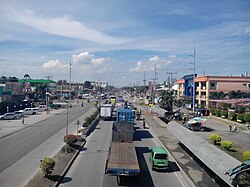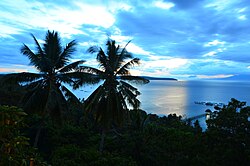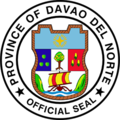Davao del Norte
Province in Davao Region, Philippines From Wikipedia, the free encyclopedia
Davao del Norte (Cebuano: Amihanang Dabaw; Filipino: Hilagang Davao), officially the Province of Davao del Norte (Cebuano: Lalawigan sa Amihanang Dabaw, Lalawigan sa Davao del Norte; Filipino: Lalawigan ng Hilagang Davao, Lalawigan ng Davao del Norte), is a province in the Philippines located in the Davao Region in Mindanao. Its capital and largest city is Tagum. The province also includes Samal Island to the south in Davao Gulf.
Davao del Norte | |
|---|---|
(from top: left to right) Kaputian Island, Tagum City, Bigiw boats in Samal, Davao Gulf, Panabo City and Samal Island. | |
| Etymology: Davao del Norte (i.e., "Northern Davao") | |
| Nickname: "Banana Capital of the Philippines" | |
 Location in the Philippines | |
| Coordinates: 7°21′N 125°42′E | |
| Country | Philippines |
| Region | Davao Region |
| Founded | May 8, 1967 |
| Capital and largest city | Tagum |
| Government | |
| • Governor | Edwin I. Jubahib (PFP) |
| • Vice Governor | De Carlo L. Uy[a] (Independent) |
| • Legislature | Davao del Norte Provincial Board |
| Area | |
• Total | 3,422.61 km2 (1,321.48 sq mi) |
| • Rank | 39th out of 81 |
| Highest elevation (Mount Masimalon) | 1,115 m (3,658 ft) |
| Population (2020 census)[3] | |
• Total | 1,125,057 |
| • Rank | 25th out of 81 |
| • Density | 330/km2 (850/sq mi) |
| • Rank | 24th out of 81 |
| Demonym | Northern Davaoeño |
| Divisions | |
| • Independent cities | 0 |
| • Component cities | |
| • Municipalities | |
| • Barangays | 223 |
| • Districts | Legislative districts of Davao del Norte |
| Time zone | UTC+8 (PHT) |
| IDD : area code | +63 (0)84 |
| ISO 3166 code | PH-DAV |
| Spoken languages | |
| Income classification | 1st class |
| Website | www |
Before 1967, the five provinces—Davao de Oro, Davao del Norte, Davao del Sur, Davao Occidental, Davao Oriental—and Guipuzcoa were administered as a single province named Davao, a provincial district of the Department of Mindanao and Sulu. The present-day Davao Region is coterminous with this former province.
Davao del Norte is also known as "The Banana Capital of the Philippines."
History
Summarize
Perspective
Davao del Norte and Davao de Oro (Compostela Valley) by R.A. 8470, January 30, 1998, together with Davao Oriental, and Davao Occidental from Davao del Sur by R.A. 10360, January 14, 2013, used to be a whole province simply known as Davao Region. This original province was split into three: Davao del Norte, Davao Oriental, and Davao del Sur when Republic Act No. 4867 (authored by Representative Lorenzo S. Sarmiento, Sr.) was signed into law on May 8, 1967, by President Ferdinand Marcos.[4]
Davao del Norte originally comprised thirteen municipalities: Asuncion, Babak (now in Samal), Compostela, Kapalong, Mabini, Mawab, Monkayo, Nabunturan, Panabo, Pantukan, Samal, Santo Tomas and Tagum. On May 6, 1970, six more municipalities were created: Carmen, Kaputian (now in Samal), Maco, Montevista, New Bataan, and New Corella.
The passage of Republic Act No. 6430 on June 17, 1972, changed the name of the province from Davao del Norte to Davao.[5]
By 1996, Davao had a total of twenty-two municipalities with the creation of San Vicente (now Laak) in 1979,[6] Maragusan in 1988,[7][8] and Talaingod in 1991.[9]
On January 31, 1998, President Fidel V. Ramos signed Republic Act No. 8470, which split the province into two, creating the province of Davao de Oro (Compostela Valley).[10] In the meantime, Davao was renamed back to Davao del Norte. Together with the creation of the new province, two cities and one municipality were created: the municipality of Tagum, capital of Davao del Norte, was converted into a city (R.A. 8472);[11] Samal, Babak, and Kaputian were joined into the city of Samal (R.A. 8471);[12] and the municipality of Braulio E. Dujali was created out of several barangays in Panabo and Carmen (R.A. 8473).[13] The province then had 8 municipalities and 2 cities.
Republic Act No. 9015, signed into law on March 5, 2001, by President Gloria Macapagal Arroyo, converted the municipality of Panabo into a city.[14] Republic Act No. 9265, approved on March 15, 2004, created the municipality of San Isidro from Asuncion and Kapalong.[15]
Geography
Summarize
Perspective
Davao del Norte covers a total area of 3,426.97 square kilometres (1,323.16 sq mi)[16] occupying the north-central section of the Davao Region. The province borders Agusan del Sur to the north, Bukidnon to the west, Davao de Oro to the east, and Davao City to the south.
Samal is the only municipality or city in the province not situated on Mindanao island. The city covers the entire Samal and Talikud Islands within Davao Gulf.
Administrative divisions
Davao del Norte comprises eight municipalities and three cities.

Political map of Davao del Norte
| ||||||||||||||||||||||||||||||||||||||||||||||||||||||||||||||||||||||||||||||||||||||||||||||||||||||||||||||||||||||||||||||||||||||||||||||||||||||||||||||||||||||||||||||||||||||||||||
Demographics
Summarize
Perspective
| Year | Pop. | ±% p.a. |
|---|---|---|
| 1903 | 9,554 | — |
| 1918 | 23,701 | +6.24% |
| 1939 | 60,349 | +4.55% |
| 1948 | 91,367 | +4.72% |
| 1960 | 262,889 | +9.21% |
| 1970 | 442,543 | +5.34% |
| 1975 | 589,697 | +5.93% |
| 1980 | 725,153 | +4.22% |
| 1990 | 1,056,301 | +3.83% |
| 1995 | 1,191,443 | +2.28% |
| 2000 | 743,811 | −9.61% |
| 2007 | 847,440 | +1.82% |
| 2010 | 945,764 | +4.08% |
| 2015 | 1,016,332 | +1.38% |
| 2020 | 1,125,057 | +2.02% |
| data prior to 2000 excludes municipalities under Davao de Oro that were part of the province until 1998. Source: Philippine Statistics Authority[17][18][18][19] | ||
Davao del Norte had a population of 1,125,057 in the 2020 census.[3] The population density was 297/km2 (768/sq mi). The province's population consists of people of Visayan descent whose ancestors came from Cebu, Bohol, Negros Oriental and Siquijor, though many of the province's residents also descended from 20th century migrants from Ilocandia, Cagayan Valley, Cordillera Administrative Region, Central Luzon, Calabarzon, Mindoro, Marinduque and Bicolandia in Luzon and Panay and Negros Occidental in Visayas. The main languages spoken are Cebuano and Davawenyo while English and Filipino are also widely spoken. Majority of the Davao del Norte residents are Roman Catholic Christians, but many of them adhere to the other Christian denominations such as Iglesia ni Cristo, Members Church of God International, Seventh Day Adventists, Pentecostal churches and Mormon Church. There is also a sizeable Muslim population in the province, many of whom are Kalagans, Maguindanaons and the migratory Maranaos with small but growing demographic of converts to Islam known as the o.
Indigenous groups
Talaingod is the home of many Indigenous groups in Davao del Norte, with most of them Lumads and Aetas.
Economy
Summarize
Perspective
Davao del Norte is a primarily agricultural, but also engages in mining, forestry, and commercial fishing.
The principal crops of the province include rice, maize, banana, coconut, abacá, ramie, coffee, and a variety of fruit and root crops. Davao del Norte is the country's leading producer of bananas, with many plantations run by multinationals Dole and Del Monte, and local producers such as Lapanday, TADECO, and Marsman. Davao del Norte is also one of Mindanao's leading producer of rice.
Davao Gulf, to the south of the province, provides a living for many fisherfolk. Some of the fish products include brackish water milkfish, tilapia, shrimp, and crab; and freshwater catfish and tilapia.
Davao del Norte is a major producer of gold, and its mining resources include silica, silver, copper, and elemental sulfur. Small-scale gold mining activities thrive in several areas. There are also numerous active quarries of commercial quantities of gravel, sand, and pebbles for construction.
Tourism is also a major part of the economy of Davao del Norte. There are a lot of beaches on Samal Island, the most famous of which is Pearl Farm Beach Resort. Banana Beach Resort is the most famous beach outside of Samal Island.
Commerce is also a major part of the economy of Davao del Norte. There are lot of shopping malls in Tagum.
Notable people
- Jerwin Ancajas - boxer
- Dennis Denora - journalist and publisher
- Thor Dulay - The Voice Ph semifinalist
- Jasmine Bacurnay Lee - Filipino-born naturalized Korean actress and politician
- Arrel Olaño - politician
- Jay Durias - singer
- Maris Racal - actress and runner-up of Pinoy Big Brother: All In
- Iwa Moto - actress, model and runner up of StarStruck (season 3)
- Edralyn P. Sonit - leaf musician, businessgirl
- Rey T. Uy, businessman, politician - then Mayor of Tagum 1998 -2001, 2004-2013 2022-present
- Allan L. Rellon - politician former mayor of Tagum 2013–2022
- Pantaleon Alvarez - politician, the current Speaker of the House of Representatives of the Philippines and a Congressman from the First District of Davao del Norte
- Yesha Camile - child actress in ABS-CBN and host for Team Yey!
- Lie Reposposa - former housemate of Pinoy Big Brother: Otso
Notes
- Uy as vice governor serves as an acting governor while Jubahib serves his 60-day preventative suspension effective April 11, 2024.[1]
References
External links
Wikiwand - on
Seamless Wikipedia browsing. On steroids.









